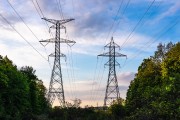In response to the global economic downturn, many world leaders have introduced significant economic stimulus packages in an effort to ramp up economic development. Seizing the opportunity to kick-start a green economy, forward-thinking governments are getting double-duty out of these plans by dedicating a significant chunk of stimulus spending towards renewable energy and efficiencies. Canada? Not so much.
It's hard to understand since it's well documented that money spent on renewable energy and energy efficiencies creates jobs and pays back returns. A report by the SEF Alliance borne out of the United Nations Environment Programme, found that "there is a strong positive relationship between clean energy/ energy efficiency/ environmental investments and economic prosperity and job growth." Countries you might not expect to go green are seeing the economic benefits of green spending. Over 30 million Chinese households are equipped with solar water heaters under the country's Golden Sun stimulus program, while the government is ag gressively moving towards reaching 30 gigawatts of wind power capacity by 2020. China's now surpassed the United States, Denmark, Germany and Spain to become the world's largest manufacturer of wind turbines, solar panels and solar water heaters. Putting renewable energy into China's economic plan has resulted in 1.12 million jobs in the industry, growing at a rate of 100,000 per year. Linking economic stimulus packages to green investments may seem like a visionary move but really, it's a no brainer. It's common sense.
gressively moving towards reaching 30 gigawatts of wind power capacity by 2020. China's now surpassed the United States, Denmark, Germany and Spain to become the world's largest manufacturer of wind turbines, solar panels and solar water heaters. Putting renewable energy into China's economic plan has resulted in 1.12 million jobs in the industry, growing at a rate of 100,000 per year. Linking economic stimulus packages to green investments may seem like a visionary move but really, it's a no brainer. It's common sense.
So what about Canada? Where is our green stimulus vision? Where is our common sense? Truth be told, it seems to be lacking. Canada's stimulus spending, which amounted to over $22 billion in 2009, dedicated just $2 billion to green spending. By contrast, green stimulus spending in the United States totalled $112 billion with 29 per cent of  that going to renewable energy investments and 32 per cent targeted at energy efficiency improvements. Similarly, Britain just unveiled their Pay as You Save scheme that will see 29 per cent of emissions from the UK's homes reduced by 2020. Of the $2 billion green stimulus spending in Canada, $1 billion was aimed at green infrastructure and another $1 billion was tagged for clean energy - at the end of the day, $1.5 billion of our green stimulus spending was directed to nuclear power and carbon capture and storage for coal - both are costly and don't provide the economic returns and environmental benefits as other options, like wind power. Smart investments from our government would instead see increased, more diverse and strategic green spending. This government's current stimulus plan - visionary? I think not.
that going to renewable energy investments and 32 per cent targeted at energy efficiency improvements. Similarly, Britain just unveiled their Pay as You Save scheme that will see 29 per cent of emissions from the UK's homes reduced by 2020. Of the $2 billion green stimulus spending in Canada, $1 billion was aimed at green infrastructure and another $1 billion was tagged for clean energy - at the end of the day, $1.5 billion of our green stimulus spending was directed to nuclear power and carbon capture and storage for coal - both are costly and don't provide the economic returns and environmental benefits as other options, like wind power. Smart investments from our government would instead see increased, more diverse and strategic green spending. This government's current stimulus plan - visionary? I think not.









